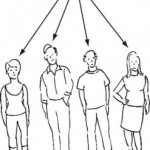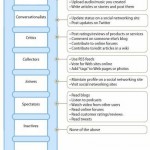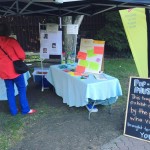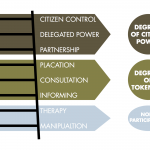Participation and engagement are terms at the forefront of any heritage and non-profit organization. With these sectors facing a steady barrage of new technology—new ways to participate!—and a constant flow of coinciding research— how to truly engage!—it’s important for us to consider what these terms mean for the Edmonton Heritage Council and their role in our organizational orchestra of staff, Directors, supporters, and collaborators.
Traditionally, audiences initiate and perpetuate relationships with organizations and there is a natural flow in which the public is introduced to the organization before moving through stages of involvement. Attempting to reroute or expand this movement can be an ambitious task; the first step is to understand the web of connections that people make with an organization they support—and for the EHC, to understand what aspects of Edmonton’s heritage and culture brings supporters into this web in the first place.
There are a variety of existing participation and engagement spectrums, each different in their approach to understanding how to influence the process or let it morph independently. The ones that stand out as possible models for the EHC are Nina Simon’s The Participatory Museum, Circles of Influence developed by the Dutch organization Deutsche AIDS-Hilfe, and finally Sherry Arnstein’s Ladder of Citizen Participation.
The Participatory Museum
- Drawing by Jennifer Rae Atkins. http://www.participatorymuseum.org/chapter1/
- Drawing by Jennifer Rae Atkins. From http://www.participatorymuseum.org/chapter1/
- Forrester’s Social Technographics
The Participatory Museum emphasizes the interactivity of audience participation. Audiences are provided with opportunities to engage with the museum by creating original content. Traditionally, audiences engage by observing and listening to an organization, but this model actively encourages audiences to cintribute ideas and opinions to create meaningful two-way interactions.
In her accompanying book, Nina Simon also focuses on Forrester Research’s ‘Social Technographics’ profile, a participation spectrum limited to digital platforms that categorizes how an individual interacts with online media. There are those who are inactive: they don’t view, visit or participate. Collectors organize content for personal or public consumption. Creators produce their own original work, while critics review, rate, and comment on the work of others. Joiners create and maintain accounts, while spectators read, watch and view content. People can fall into multiple categories depending on their interests and the nature of the media.
- Neighbourhood pop-up exhibits are an opportunity for citizens to contribute their own stories.
- Edmontonians invited to share what places matter to them for an ECAMP project.
Simon reinforces that technology is the most effectual, boundless, and ultimately free resource there is. The EHC has been exploring participatory online platforms with the Edmonton City as Museum Project, the Edmonton Heritage Network, and Edmonton Maps Heritage—each providing pathways for citizens to share what is important to them in a growing conversation about heritage in Edmonton.
Circles of Influence
- From http://www.pq-hiv.de/en/methode/circles-influence
If The Participatory Museum highlights the multitude of ways in which audiences engage, the Circles of Influence model shows how these various levels of audience participation co-create the foundation of thought and dialogue within the organization.
The ‘decision-making authority’ (usually the organization) is placed as the center of a circle, with several strata of participants placed into increasingly wider surrounding rings representing decreasing participation towards the outside ‘non-participatory’ edge.
The circles visualize movement through the organization as well as the extent that each person is invested, and helps highlight the potential for collaboration within and between rings. Audience interaction might be explored more thoroughly by a community-oriented organization by inverting the model: placing the public as the ‘decision-making authority’, and considering how the relationship change would ripple out to the organization being situated in the ‘information’ or ‘consultation’ position.
As an advocate, facilitator, and activator within the broader heritage community, the Edmonton Heritage Council likes to look at ourselves in this way—with the public in the driver’s seat leading progress in Edmonton’s heritage.
Ladder of Citizen Participation
The final framework that speaks directly to audience-driven engagement is Sherry Arnstein’s Ladder of Citizen Participation. The model envisions interactions between the public and the organization as a ladder: on the bottom rung is ‘non-participation’, citizens whose interests and understanding may align with the organization. On the top, ‘citizen control’, in which the community develops and implements decisions with only resource investment and support on the part of the organization.
Think ECAMP’s Partnership Demonstrations, small micro-grants which have supported the creation of citizen led projects like Heroes of 107th Avenue and Mill Woods Mythologies to local movements like RISE – Reconciliation in Solidarity Edmonton.
—
The world is increasingly tech-savvy, and the opportunities for connections between organizations and citizens has never been greater. The web and social media are inexpensive tools for change and can mitigate many of the challenges organizations face in refining their membership model, seeking new forms of participation, or rerouting engagement. These are just a few of the many models out there that provide inspiration for the EHC.
As the Edmonton Heritage Council continues advancing our mission and expand our audiences, the world around us is likewise evolving. Participation and engagement spectrums provide a map of people moving through our organization, and how their contributions, motives, and opportunities change. This reflection will continue into the future as EHC looks to refine its membership and outreach as an opportunity to connect and energize Edmontonians and the city’s heritage.






